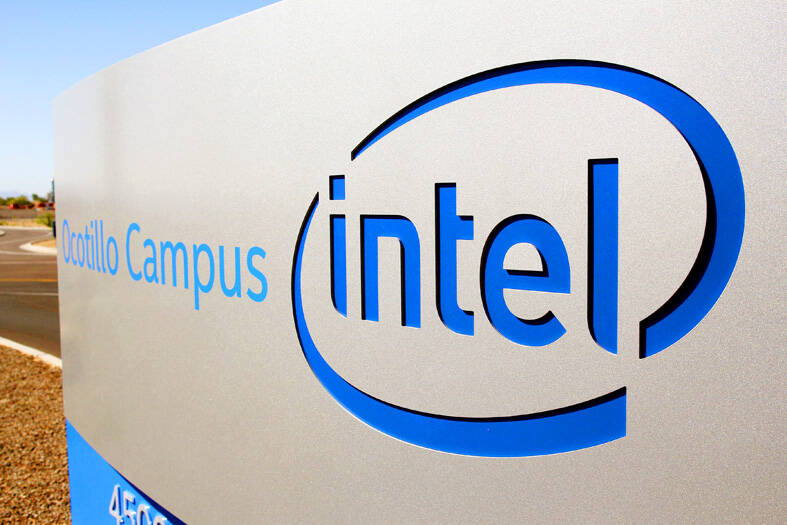Intel Corp is further delaying the opening of a much-touted new semiconductor complex in Ohio, marking the latest setback to the chipmaker’s expansion plans.
The first plant, originally scheduled to begin operating this year, now would not be completed until 2030, the company said in a statement on Friday.
The factory is slated to begin running either that year or in 2031, Intel said. The completion of a second plant was postponed until 2031, with operations potentially starting the following year.

Photo: Reuters
“As we continue to invest across our US sites, it’s important that we align the start of production of our fabs with the needs of our business and broader market demand,” Intel executive vice president and chief global operations officer Naga Chandrasekaran said in the statement.
“This has always been our approach, as it allows us to manage our capital responsibly and adapt to the needs of our customers,” he said. Intel, struggling with shrinking sales and mounting losses, has been scaling back efforts to add more manufacturing capacity. The Ohio site has been a symbol of the company’s comeback hopes — and a broader US push to rebuild the country’s domestic chip production. Intel has had ambitions to turn it into the world’s largest semiconductor facility.
The chipmaker, which had dominated the industry for decades, is a major recipient of federal funds as part of the US’ CHIPS and Science Act — bipartisan legislation enacted during former US president Joe Biden’s administration to reverse a shift of manufacturing toward East Asia.
Taxpayer support is contingent on the company reaching milestones in construction, equipping the factories and then starting production. Intel was scheduled to receive US$7.9 billion in direct funding.
It is not unusual for chip companies to build the shell of new factories and then delay the final steps — installing the expensive equipment used to make the semiconductors — while they wait for demand to improve, but the Ohio facility was seen as a crucial piece of Intel’s strategy. The company has been pivoting into the role of a chip foundry, a business that makes electronics for outside clients.
The company’s plans have been in flux in recent months. Intel ousted chief executive officer Pat Gelsinger late last year and has not named a new permanent leader.
Investors have even been betting that the company might be sold in pieces — a scenario that has fueled a stock rebound this year after a steep decline last year.
In January, Intel’s interim leaders said they would pursue a more cautious, less expansive strategy than Gelsinger did. That means not adding capacity before demand justifies it, or touting big customer wins until that revenue is secured.

SEEKING CLARITY: Washington should not adopt measures that create uncertainties for ‘existing semiconductor investments,’ TSMC said referring to its US$165 billion in the US Taiwan Semiconductor Manufacturing Co (TSMC, 台積電) told the US that any future tariffs on Taiwanese semiconductors could reduce demand for chips and derail its pledge to increase its investment in Arizona. “New import restrictions could jeopardize current US leadership in the competitive technology industry and create uncertainties for many committed semiconductor capital projects in the US, including TSMC Arizona’s significant investment plan in Phoenix,” the chipmaker wrote in a letter to the US Department of Commerce. TSMC issued the warning in response to a solicitation for comments by the department on a possible tariff on semiconductor imports by US President Donald Trump’s

The government has launched a three-pronged strategy to attract local and international talent, aiming to position Taiwan as a new global hub following Nvidia Corp’s announcement that it has chosen Taipei as the site of its Taiwan headquarters. Nvidia cofounder and CEO Jensen Huang (黃仁勳) on Monday last week announced during his keynote speech at the Computex trade show in Taipei that the Nvidia Constellation, the company’s planned Taiwan headquarters, would be located in the Beitou-Shilin Technology Park (北投士林科技園區) in Taipei. Huang’s decision to establish a base in Taiwan is “primarily due to Taiwan’s talent pool and its strength in the semiconductor

An earnings report from semiconductor giant and artificial intelligence (AI) bellwether Nvidia Corp takes center stage for Wall Street this week, as stocks hit a speed bump of worries over US federal deficits driving up Treasury yields. US equities pulled back last week after a torrid rally, as investors turned their attention to tax and spending legislation poised to swell the US government’s US$36 trillion in debt. Long-dated US Treasury yields rose amid the fiscal worries, with the 30-year yield topping 5 percent and hitting its highest level since late 2023. Stocks were dealt another blow on Friday when US President Donald

UNCERTAINTY: Investors remain worried that trade negotiations with Washington could go poorly, given Trump’s inconsistency on tariffs in his second term, experts said The consumer confidence index this month fell for a ninth consecutive month to its lowest level in 13 months, as global trade uncertainties and tariff risks cloud Taiwan’s economic outlook, a survey released yesterday by National Central University found. The biggest decline came from the timing for stock investments, which plunged 11.82 points to 26.82, underscoring bleak investor confidence, it said. “Although the TAIEX reclaimed the 21,000-point mark after the US and China agreed to bury the hatchet for 90 days, investors remain worried that the situation would turn sour later,” said Dachrahn Wu (吳大任), director of the university’s Research Center for